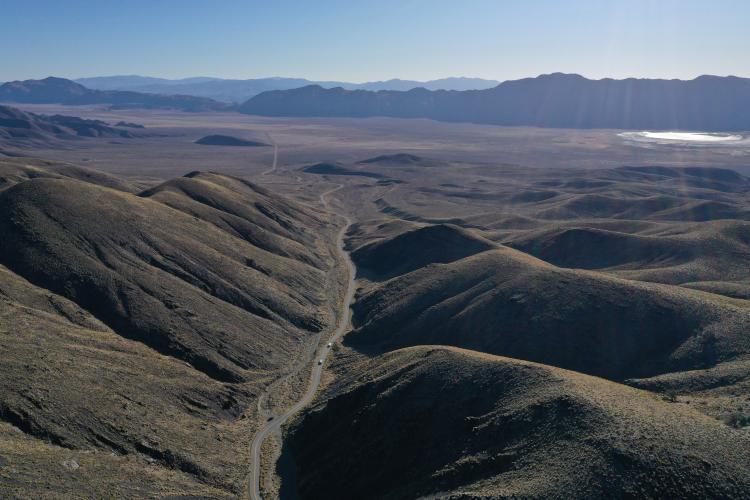![White Mountain East - The Elephant Cycling White Mountain - roadway, meadow, mountains and clouds]()
Cycling White Mountain
#41 US
18.1 miles gaining 5,115’ at 5.1% average grade.
The first of two segments of this climb begins at Highway 168 adjacent to “The Elephant” which is an appropriately named hill formation that is in the middle of the photo above (trunk extending to the road and the head to the left). Segment 1 is 8.1 miles gaining 2,110’ at 4.9% average grade. This climb overlaps Westgard Pass - they share the same start and Westgard Pass is just a quarter mile from the turn off from Hwy 168 to White Mountain Road.
![White Mountain East White Mountain East - bike by road]()
Start
![White Mountain - mini-canyon on Hwy 168 cycling White Mountain Road - Bristlecone Forest - cyclist riding bike through narrow canyon on hwy 168]()
A mile from the start on a VERY straight road!
![White Mountain - mini-canyon on Hwy 168 cycling White Mountain Road - Bristlecone Forest aerial drone photo of hwy 168 from Big Pine]()
The first part of this bike climb are through a canyon on Hwy 168.
![]()
The second segment of the climb begins at White Mountain Road (9.5 miles, 3,029', at 6.2%).
![White Mountain - mini-canyon on Hwy 168]()
Turn off Highway 168 at mile 8.2
![White Mountain - mini-canyon on Hwy 168 Bicycle ride up White Mountain - hwy 168 roadway, canyon]()
No charge for entering on a bike.
![White Mountain - mini-canyon on Hwy 168 bike climb White Mountain Road - Bristlecone Forest - aerial drone of eastern sierras and owens valley]()
Aerial drone view from Serra View Overlook at mile 16.
View of Eastern Sierras across Owens Valley (Bishop center left)
![White Mountain - mini-canyon on Hwy 168 Cycling White Mountain Road - Bristlecone Forest - aerial drone photo of Schulman Grove and Serra View Overlook.]()
Last 2 miles of the climb.
Serra View Overlook center right; Schulman Grove center left (cannot be seen from this photo)
![White Mountain Road - Bristlecone Forest White Mountain Road bike climb - Bristlecone Forest sign, roadway and mountains]()
The Ancient Bristlecone Pine Forest on White Mountain Road --
home to the oldest trees in the world, bristlecone pines.
National Park Service - Ancient Bristlecone Pine Forest
![White Mountain Road - near the finish Climbing White Mountain Road by bike - 10,000' elevation sign, road, clouds]()
The second highest paved road in California at 10,119’ (114’ lower than Rock Creek).
![]()
End of the line . . .
. . . unless you brought your mountain bike! White Mountain Peak.
![]()
The climb ends about 0.3 miles south of the Ancient Bristlecone Pine Forest Visitor Center, home to the world's oldest living tree, and there are some breathtaking views of the Eastern Sierras to the west as you near the summit. The lower portion of the climb is arid and desert-like, as you would expect for a ride that begins at Death Valley Road, but it gives way to a more high sierra alpine setting as you climb into the Inyo National Forest.

 We've partnered with Sherpa-Map.com to bring you the best route planning tool. With a PRO Membership you can use this climb as a reference when creating your route.
We've partnered with Sherpa-Map.com to bring you the best route planning tool. With a PRO Membership you can use this climb as a reference when creating your route. 

